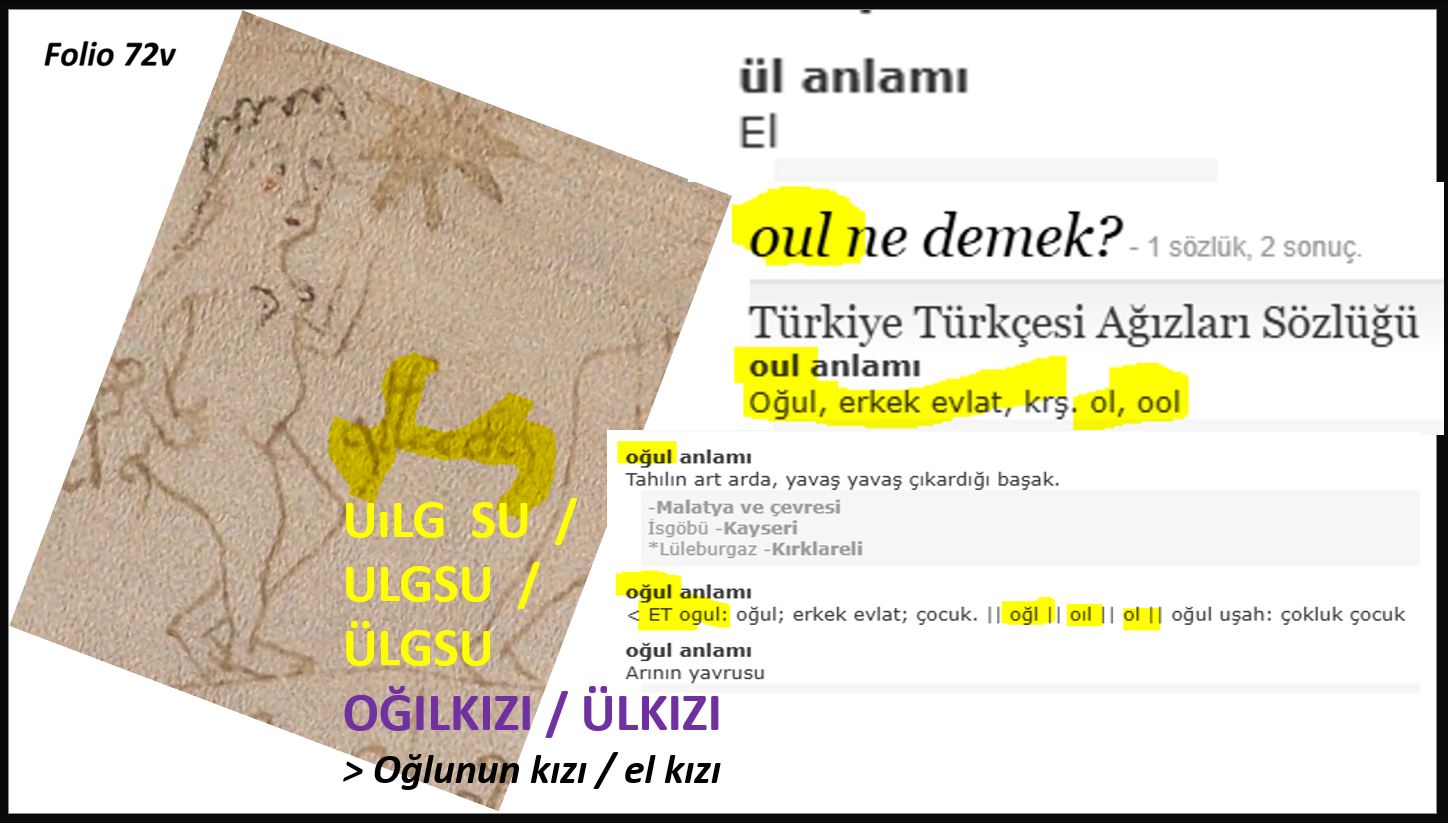OĞUL-KIZI / EL-KIZI

OĞUL-KIZI / EL-KIZI
Original-Latin : UıLGSU / ULGSU / ÜLGSU
Transcript :
Burada “UIL” veya "UL" yada "ÜL" biçiminde yazılmış olan sözcük köküne -GSU (KIZI) biçiminde yazılmış sözcüğün eklenmesiyle bir bileşik sözcük oluşturulmuştur. Bu ifade cinsiyet belirten bir yakınlık adlandırmasıdır. Burada yazarın (ATA alfabe transkripsiyonuna esasen) “UIL” ve "UL" veya "ÜL" okunur biçiminde yazmış olduğu sözcük fonetik değerce günümüz Türkçe ağızlarında "OIL / OĞUL" seslendirilen (oğul) sözcüğü ile "ÜL" biçiminde söylenen (el/elalem; yabancı, akraba olmayan anlamındaki) sözcüğe fonetik değeri bakımından en yakındır.
Yazarın burada UıL/UL okunur biçimde yazdığı sözcüğü Eski Türkçe ve günümüz ağızlarında OL, OOL, OĞL, OIL, UIL/OUL gibi ses biçimlerinde görebiliyoruz. Burada bu sözcüğün bir kadın adlandırması olduğunu ve anlamının ise "0ğlunun kızı" (kız torun) veya "el-kızı" (yabancı/akraba-olmayan kız) anlamında kullanıldığı söylenebilir.
Bu "ÜL" ve "UIL/UL" okunabilen sözcüğün VM-sayfaları boyunca tümce içinde nasıl kullanıldığı net biçimde değerlendirildiğinde bu olasılıklardan hangisi olduğu net biçimde söylenebilecektir. Ancak her iki olasılığın cinsiyet olarak bir kadın adlandırması oldukça nettir. İşte bu durum çizimle sözcükler arasında bir örtüşme örneğidir ki 72v sayfasında çok sayıda benzer biçimde kadın adlandırmaları da zaten kaydedilmiştir.
Ayrıca VM araştırmacıları arasında harita sayfası olarak bilinen sayfadaki bir tümcede de bu sözcüğü okumuştuk ve orada da aynen burada gösterdiğimiz açıklamaların benzerini yapmıştık. Bu sebeple burada 72v sayfasında aynı sözcüğün yine aynı anlam içeriğiyle ve aynı fonetik yazım biçiminde kullanılması bir anlamda transliterasyon ve transkripsiyon çalışmalarımızda doğru çıkarımlar yaptığımızın göstergelerinden birisidir.
---- / ----
Here, a compound word is created by adding the word written as -GSU (HIS/HER DAUGHTER) to the root word written as "UIL" or "UL" or "ÜL." This expression is a gender-specific affinity designation. The word written here (based on the ATA alphabet transcription) as "UIL" and "UL" or "ÜL" is phonetically closest to the word "son" pronounced "OIL/OĞUL" in modern Turkish dialects, and the word pronounced "ÜL" (el/elalem; meaning foreign, unrelated/unfamiliar girl).
The word written here as UıL/UL by the author can be seen in Old Turkish and modern dialects in phonetic forms such as OL, OOL, OĞL, OIL, and UIL/OUL.
It can be said that this word is a feminine designation and that its meaning is "son's daughter" (son's daughter or daughter-in-law) or "el-kızı" (foreign/unrelated daughter).
A clear assessment of how this word, readable as "ÜL" and "UIL/UL," is used within sentences throughout the VM pages will determine which of these possibilities is the case. However, it is quite clear that both possibilities refer to a woman as the gender.
This is an example of overlap between the drawing and the words, as numerous similar female names/references are already recorded on page 72v.
We also read this word in a sentence on the page known among VM researchers as the map page, and there we provided explanations similar to those presented here. Therefore, the use of the same word with the same semantic content and phonetic spelling here on page 72v is, in a sense, an indication that we have made accurate inferences in our transliteration and transcription studies.
